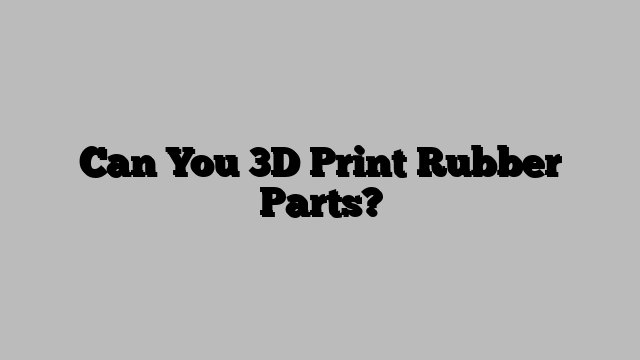When it comes to 3D printing, the ability to create objects out of a wide range of materials is a major advantage. However, not all materials are equally suited for 3D printing, and some, like rubber, require specific equipment and techniques. In this article, we’ll explore the topic of 3D printing rubber parts and what you need to know to get started.
Can You 3D Print Rubber Parts?
Yes, it is possible to 3D print rubber parts. However, it requires a specific type of 3D printer and material. Traditional fused deposition modeling (FDM) 3D printers, which use a melted plastic filament, cannot 3D print rubber. Instead, you need a specialized 3D printer that uses a different technology called “material jetting.”
Material jetting 3D printers use a liquid photopolymer resin that is cured (hardened) by a UV light after it is deposited. This process allows for the creation of complex shapes and intricate details, and it is ideal for creating rubber parts.
The rubber-like material used in material jetting 3D printing is called “polyjet” or “tango” material. It is a flexible, rubber-like material that can be used to create parts with a variety of properties, such as softness, elasticity, and durability.
Benefits of 3D Printing Rubber Parts
The ability to 3D print rubber parts offers a range of benefits, including:
Customization: With 3D printing, you can create rubber parts that are tailored to your specific needs and requirements. This can be especially useful in industries like healthcare, where custom-fit devices can be crucial.
Speed: 3D printing can produce rubber parts quickly and efficiently, with minimal setup time required. This makes it a great option for prototyping and low-volume production runs.
Cost-effectiveness: 3D printing can be a cost-effective way to produce rubber parts, especially for low-volume runs or one-off custom pieces.
Challenges of 3D Printing Rubber Parts
While there are many benefits to 3D printing rubber parts, there are also some challenges to keep in mind. These include:
Limited size: Material jetting 3D printers are typically limited in the size of the parts they can produce, which can be a disadvantage for larger rubber parts.
Material properties: While polyjet or tango materials can be tailored to specific properties, they may not be suitable for all applications. It is important to choose the right material for your intended use.
Post-processing: 3D printed rubber parts may require post-processing, such as cleaning and curing, to achieve their final properties.
Conclusion
3D printing rubber parts is a viable option for those looking to create custom parts with specific properties. However, it requires a specialized 3D printer and material, as well as knowledge of the specific properties and limitations of the materials used. If you are interested in 3D printing rubber parts, be sure to do your research and choose the right equipment and materials for your needs.
